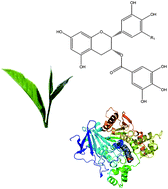Inhibition of acetylcholinesterase by green and white tea and their simulated intestinal metabolites
Abstract
By 2034 it is forecast that 5% of the global population will be aged 85 years or over—approximately two and half fold increase on present day figures—which will inevitably lead to an increase in age-associated disorders such as Alzheimer's disease. There is mounting evidence that green tea (Camellia sinensis) possesses numerous health-promoting properties, and may potentially be beneficial to those suffering from Alzheimer's and other diseases, including cardiovascular disease and cancer. These beneficial properties are largely attributed to the high polyphenol content, particularly the catechins. In this study, we measured acetylcholinesterase inhibition by white and green teas and their simulated intestinal digests. We found that the potency with which the white and green tea extracts inhibited acetylcholinesterase varied through the simulated digestion procedure. Initially, in the undigested extract form, potency was high with IC50 values of 7.20 μg mL−1 and 8.06 μg mL−1 for green and white tea respectively. However, this decreased significantly after gastric digestion but activity was recovered after pancreatic digestion which could be related to relative increases in the levels of caffeine and specific phenolic components. Of the pure tea compounds tested, EGCG was the most potent with an IC50 of 0.0096 μmol mL−1 but its breakdown product; γ-valerolactone was the least potent analyte. Particularly interesting were the results of caffeine, which exhibited a strong inhibitory activity and pyrogallol, which recorded a much stronger potency than its parent compound gallic acid, suggesting a pro-drug-like relationship. Overall, the results indicate that further research is necessary to determine the full potential of digestion of tea and its metabolites and how inter-individual variation may indicate that some sections of society could potentially benefit more from drinking tea as a strategy to prevent the development of dementia. We have also shown the activities of a number of metabolites, however, further research is required to determine their potential bioavailability.


 Please wait while we load your content...
Please wait while we load your content...